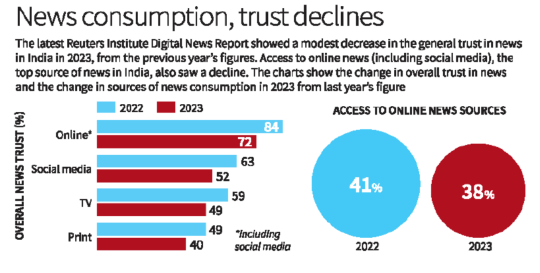News consumption falls in India, says study
Context:
The Reuters Institute Digital News Report, 2023, published on Wednesday, found that overall news consumption and sharing in India decreased from last year’s figures along with a sharp decline in access to online news (-12 percentage points), while television also experienced a 10 percentage point decline as a news source.
Points to Ponder:
- The decline in News Consumption Overall: According to the research, news consumption and sharing in India are down from the previous year.
- Reduction in Online News Access: There has been a notable 12 percentage point reduction in online news access. This suggests that Indian consumers are changing the way they consume news.
- Decline of Television as a News Source: There has been a 10 percentage point drop in the use of television as a news source. This shows that viewers are becoming less reliant on conventional TV news sources.
- Trust in News: India had a little decline in overall trust in the news of 3 percentage points. The nation received a score of 24 out of 46 for news trust. The countries with the highest rates of trust were Finland (69%) and Greece (19%).
- Public Broadcasters: In the Indian study, respondents still had a high degree of trust in public broadcasters including DD India, All India Radio, and BBC News. This emphasises how crucial public service media are to upholding credibility.
- Preferred Social Media Platforms: With 56% of respondents using YouTube to access news in India, it has emerged as the most popular social media channel for news. Facebook (39%) and WhatsApp (47%) were the second most popular news platforms.
- Dainik Bhaskar: One of the top 10 brands that survey participants viewed both online and offline was the Hindi newspaper, Dainik Bhaskar. This demonstrates its acceptance and sway in the Indian news business.
- Rise of Video-Based Information: According to the report, the news is increasingly relying on video-based information published on websites like TikTok, Instagram, and YouTube, particularly in portions of the Global South. This shows a move towards interactive and visual news formats.
- Facebook’s Importance Is Declining: Across the board, Facebook’s importance as a news source is declining. Compared to 42% in 2016, only 28% of respondents in India used Facebook to receive news in 2023. The fall in news on Facebook and the emergence of TikTok and YouTube are cited as causes.
- Importance of Social Media Influencers: Social media influencers are crucial because, when it comes to news themes, users of apps like TikTok, Instagram, and Snapchat paid more attention to celebrities and social media influencers than to journalists and media outlets. This makes it difficult for conventional media to hold the interest of younger consumers.
- A decline in Direct Visits to News Websites: Around the world, the percentage of people who claim that news websites or apps are their primary source of news has decreased from 32% in 2018 to 22% in 2023. This shows a decrease in people visiting news websites directly and a rise in people accessing news through social media.
- News podcasting: Although it’s still a relatively uncommon activity overall, news podcasting continues to appeal to educated and younger audiences. A monthly podcast was accessed by about 34% of respondents, and a news and current affairs broadcast was accessed by 12% of respondents.
- News Avoidance: The analysis identifies a persistent pattern of news avoidance in numerous nations, which is partially caused by factors connected to mental health. Infrequently, 53% of news avoiders attempted to avoid all news, while 32% preferred to steer clear of “difficult topics.”




